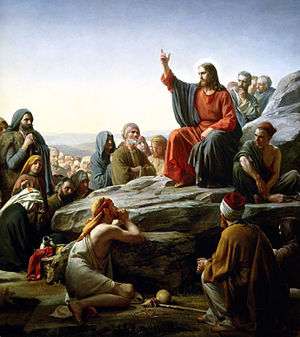Turning the other cheek

Turning the other cheek, also known as offering [one's] cheek, is a phrase in Christian doctrine that refers to responding to injury without revenge.
Scriptural reference
The phrase originates from the Sermon on the Mount in the New Testament. In the Gospel of Matthew, an alternative for "an eye for an eye" is given by Jesus:
38 Ye have heard that it hath been said, An eye for an eye, and a tooth for a tooth:
39 But I say unto you, That ye resist not evil: but whosoever shall smite thee on thy right cheek, turn to him the other also.
40 And if any man will sue thee at the law, and take away thy coat, let him have thy cloke also.
41 And whosoever shall compel thee to go a mile, go with him twain.
42 Give to him that asketh thee, and from him that would borrow of thee turn not thou away.
In the Sermon on the Plain[1] in the Gospel of Luke, as part of his command to "love your enemies", Jesus says:
27 But I say unto you which hear, Love your enemies, do good to them which hate you,
28 Bless them that curse you, and pray for them which despitefully use you.
29 And unto him that smiteth thee on the one cheek offer also the other; and him that taketh away thy cloke forbid not to take thy coat also.
30 Give to every man that asketh of thee; and of him that taketh away thy goods ask them not again.
31 And as ye would that men should do to you, do ye also to them likewise.
This passage is variously interpreted as commanding nonresistance, Christian pacifism or nonviolence on the part of the victim.
Interpretations
This phrase, as with much of the Sermon on the Mount, has been subject to both literal and figurative interpretations.
Christian anarchist interpretation
Since the passages call for total nonresistance to the point of facilitating aggression against oneself, and since human governments defend themselves by military force, some have advocated Christian anarchism, including Leo Tolstoy who elucidated his reasoning in The Kingdom of God Is Within You.
Nonviolent resistance interpretation
The scholar Walter Wink, in his book Engaging the Powers: Discernment and Resistance in a World of Domination, interprets the passage as ways to subvert the power structures of the time.[2] He says that at the time of Jesus, striking someone deemed to be of a lower class with the back of the hand was used to assert authority and dominance. If the persecuted person "turned the other cheek," the discipliner was faced with a dilemma. The left hand was used for unclean purposes, so a back-hand strike on the opposite cheek would not be performed. An alternative would be a slap with the open hand as a challenge or to punch the person, but this was seen as a statement of equality. Thus, by turning the other cheek the persecuted was demanding equality.
Wink continues with an interpretation of handing over one's cloak in addition to one's tunic. The debtor has given the shirt off his back, a situation forbidden by Hebrew law as stated in Deuteronomy (24:10–13). By giving the lender the cloak as well the debtor was reduced to nakedness. He notes that public nudity was viewed as bringing shame on the viewer, not just the naked, as seen in Noah's case (Genesis 9:20–23).
Wink interprets the succeeding verse from the Sermon on the Mount as a method for making the oppressor break the law. The commonly invoked Roman law of Angaria allowed the Roman authorities to demand that inhabitants of occupied territories carry messages and equipment the distance of one mile post, but prohibited forcing an individual to go further than a single mile, at the risk of suffering disciplinary actions.[3] In this example, the nonviolent interpretation sees Jesus as placing criticism on an unjust and hated Roman law as well as clarifying the teaching to extend beyond Jewish law.[4]
Righteous personal conduct interpretation
Another interpretation is that Jesus was not changing the meaning of "an eye for an eye and a tooth for a tooth" but restoring it to the original context. Jesus starts his statement with "you have heard it said", which could mean that he was clarifying a misconception, as opposed to "it is written" which could be a reference to scripture. The common misconception seems to be that people were using Exodus 21:24-25 (the guidelines for a magistrate to punish convicted offenders) as a justification for personal vengeance. In this context, the command to "turn the other cheek" would not be a command to allow someone to beat or rob a person, but a command not to take vengeance.
See also
- Brotherly love (philosophy)
- But to bring a sword
- Christian pacifism
- Expounding of the Law#Retaliation
- Live by the sword, die by the sword
- Sell your cloak and buy a sword
- Tolstoyan
- Violence begets violence
References
- ↑ Luke 16:17 - This is a different location than the sermon on the mount of Matthew.
- ↑ Wink, Walter (1992). Engaging the Powers: Discernment and Resistance in a World of Domination. Fortress Press. pp. 175–182. ISBN 978-0800626464. Retrieved December 27, 2013.
- ↑ Th. Mommsen. Codex Theodosianus 8:5:1.
- ↑ Michael Avi-Yonah. The Jews Under Roman and Byzantine Rule: A Political History of Palestine from the Bar Kokhba War to the Arab Conquest.
Further reading
- Jim Douglass, Lightning from East to West: Jesus, Gandhi, and the nuclear age, 1983 ISBN 0-8245-0587-5